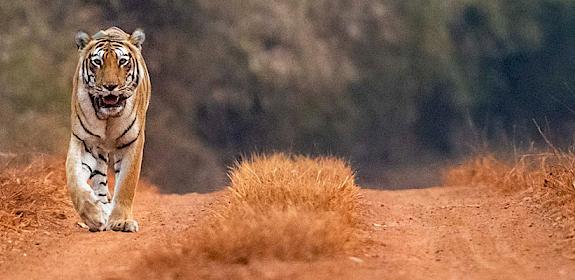Shared vision for the future of an iconic cat in the Year of the Tiger
As the Year of the Tiger begins, a coalition of six top NGOs is committing to a cooperative approach to save the iconic big cat. Authors from IUCN, FFI, WCS, WWF, TRAFFIC and Panthera argue that ambition must increase and that funders must support collaborative efforts.
In the past 12 years, tigers increased significantly in some areas but disappeared from others: a close assessment of these trends is key in advance of the next Global Tiger summit in September 2022.

In 2010, the 13 countries that still retained tiger populations in the wild converged on St. Petersburg, Russia, to sign a summit declaration to double the number of tigers before the next Lunar “Year of the Tiger” in 2022.
As we approach the upcoming second Global Tiger summit on September 5, 2022, in Vladivostok, Russia, it is vital we assess the progress and failures of the tiger recovery efforts thus far. In the past 12 years, tiger numbers have increased significantly in some areas, while tigers have disappeared from others. Overall, this first phase of the Global Tiger Recovery Program shows that tiger numbers can be restored but that progress is hard-won and fragile – tiger conservation needs to be urgently strengthened to achieve long-term success. Therefore we must regroup and reassess how to move forward to build a more successful, collaborative effort with a clear vision that provides spatial prioritization of where we need to focus for tigers and what specifically needs to be done to ensure the survival and recovery of viable, ecologically functional wild tiger populations across their historical range.
Back in 2010 there was no universal consensus on the best approaches for tiger conservation. There were debates in the scientific literature and in the halls of conferences and workshops, some friendly, some heated. Of course some debates continue, but as we head into the next 12 years of tiger conservation, there is clear consensus now on many things. We know what it takes to save tigers. There are multiple models of success that have similar and predictable parameters that can be emulated. There has been a convergence of thinking on best approaches to tiger conservation. We are developing a catalogue of lessons learned and applying those lessons where people are open to adopt the practices. And we are learning how to better cooperate in pursuit of a greater good.
Perhaps most importantly, we have learned that tiger conservation cannot be considered or executed as a single species conservation initiative, but rather as a platform for addressing some of the major global concerns facing both natural and human-dominated communities. Single species conservation efforts, even those focused on charismatic wildlife such as tigers, are susceptible to insufficient political and financial support unless they also incorporate broader environmental priorities and address the significant challenges that face the relevant governing bodies.
Perhaps because the tiger is such an iconic species, there has, up to now, been little attempt to place tiger conservation in the context of global concerns such as climate change, zoonotic diseases, and the destabilizing effects of forest loss and ecosystem degradation. Far from being isolated and independent issues, these challenges are intricately linked, and success in any one arena will require a much more comprehensive approach.
In this context, at least in Asia, tigers can act as an umbrella not just to protect other species, but to retain ecosystem integrity, stabilize climate, and promote a “One Health” strategy that recognizes that human health, animal health and the health of the planet are inextricably linked. As such, tiger conservation provides a convenient and effective umbrella to tackle multiple threats potentially destabilizing both human and wildlife populations of Asia which, despite holding about 60% of the world’s human population, is still one of the most biologically diverse regions of the world.
Collaboration is a critical component of conservation success. The NGO community has been known for its competitive nature within the conservation world, for instance, as many organizations seek support from the same funding sources. This ironically has sometimes led to a perverse focus on outcompeting other organizations rather than collectively achieving our aligned conservation goals. While competition can be a powerful and useful force leading to improvements in effort and strategic approaches, the competitive nature of funding for conservation can limit success by disincentivizing collaboration between multiple organizations with varied strengths.

This Year of the Tiger, we – Fauna and Flora International (FFI), International Union for the Conservation of Nature (IUCN), Panthera, TRAFFIC, Wildlife Conservation Society (WCS) and World Wildlife Fund (WWF) – have united under a shared vision for Securing a Viable Future for the Tiger. As a group of organizations that has worked for decades with partners to conserve tigers, our joint vision is for a long-term presence of viable and ecologically functional populations of wild tigers secure in their natural habitats, with representation and links across their indigenous range, respected and valued by neighboring human communities and beyond, a magnificent symbol of nature in all its beauty, complexity and wonder for future generations.
We have proposed four primary goals over the next 12 years of tiger conservation:
1) secure and increase numbers of tigers in all existing populations;
2) expand the range of tigers by managing environments so as to encourage expansion into new areas;
3) turn the tide by reintroducing tigers into countries and landscapes that have lost their tiger populations;
4) restore ecological diversity by recovering and sustaining tiger populations in all major ecological settings of the tiger’s indigenous range.
To achieve these goals, we pledge our support to help the range countries strengthen the Global Tiger Initiative by securing robust and sustainable long-term funding. We further call on funding mechanisms to dispel systems that encourage separate, competitive actions of conservation actors as it is an ineffective and outdated approach. Instead, we must usher in a new era of collaboration. Funding organizations can support this process by encouraging collaborative efforts, rather than reinforcing the competitive nature of funding single organizations in the status quo.
Our collaboration resulting in a single voice for advocacy and investment in conservation interventions is a much-needed transition as we enter the next phase of tiger conservation and the Global Tiger Recovery Program. We are ready and keen to continue our support of the tiger range countries in securing key tiger areas, countering the threats from trade, enabling human-wildlife coexistence and sharing good practices in the development of green infrastructure and, where feasible, planning for wild tiger population restoration.
And we will be imploring governments of tiger range countries, donor organizations and the global public to understand that saving tigers is about much more than saving a single species: it is about saving Asia – its abundance of resources, its climate, and the health of its people and other living inhabitants. Hence, while saving tigers is not a balm for all that ails Asia, it is an extremely good start.
Saving tigers will make Asia and the whole world a better and healthier and safer place for us all to live. And to that, we will commit our resources, our energy, and our collective will.
Signed,
Dale Miquelle, Tiger Program Coordinator, WCS
Sugoto Roy, Coordinator, Integrated Tiger Habitat Conservation Programme, IUCN
Stuart Chapman, Leader of the Tigers Alive Initiative, WWF
Abishek Harihar, Deputy Director Tiger Program, Panthera
Christine Breitenmoser, Co-chair, IUCN SSC Cat Specialist Group
Debbie Martyr, Technical Advisor, Kerinci Seblat Tiger Protection & Conservation, FFI
Dechen Dorji, Sr Director, Asia Wildlife, WWF-US
Elizabeth Bennett, Vice President, Species Conservation, WCS
John Goodrich, Chief Scientist and Tiger Program Director, Panthera
Luke Hunter, Executive Director, Big Cats Program, WCS
Micheal Belecky, Policy Lead, Tigers Alive Initiative, WWF
Urs Breitenmoser, Co-chair, IUCN SSC Cat Specialist Group
Saket Badola, Tiger Trade Lead, TRAFFIC
- Commentary originally published by Mongabay




